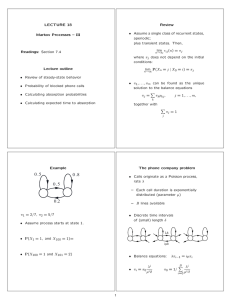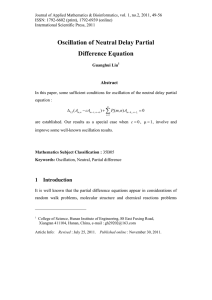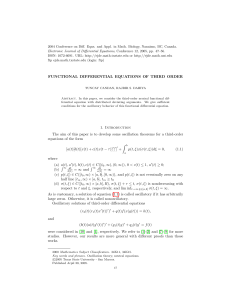Math 554 Iowa State University Introduction to Stochastic Processes Department of Mathematics
advertisement
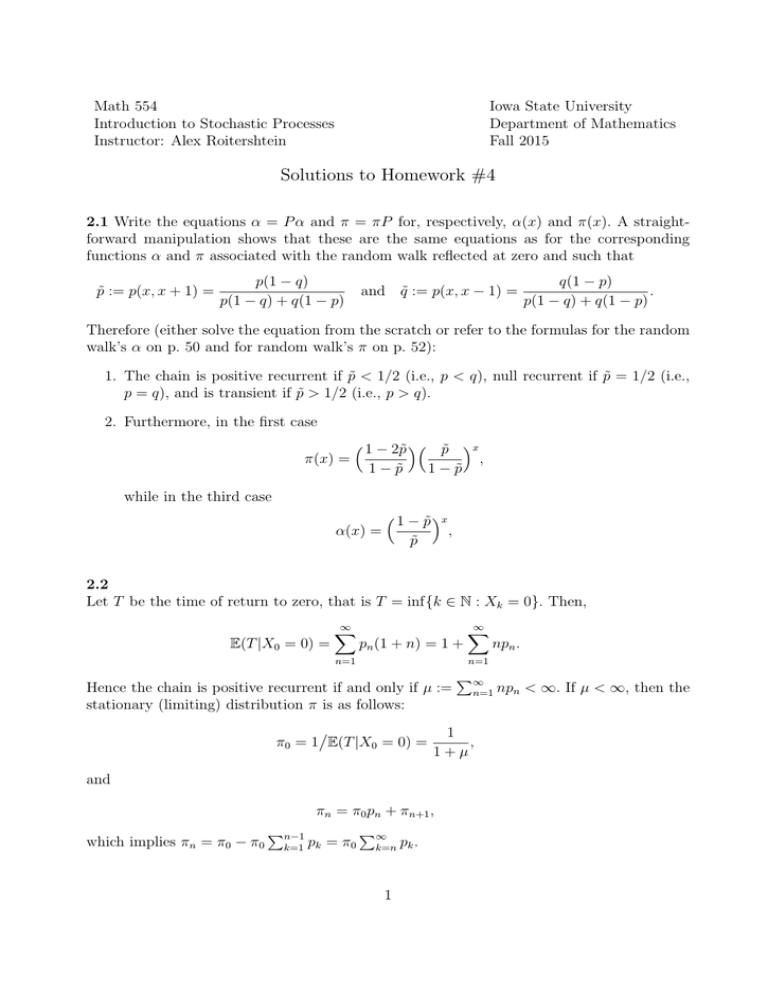
Math 554
Introduction to Stochastic Processes
Instructor: Alex Roitershtein
Iowa State University
Department of Mathematics
Fall 2015
Solutions to Homework #4
2.1 Write the equations α = P α and π = πP for, respectively, α(x) and π(x). A straightforward manipulation shows that these are the same equations as for the corresponding
functions α and π associated with the random walk reflected at zero and such that
p̃ := p(x, x + 1) =
p(1 − q)
p(1 − q) + q(1 − p)
and q̃ := p(x, x − 1) =
q(1 − p)
.
p(1 − q) + q(1 − p)
Therefore (either solve the equation from the scratch or refer to the formulas for the random
walk’s α on p. 50 and for random walk’s π on p. 52):
1. The chain is positive recurrent if p̃ < 1/2 (i.e., p < q), null recurrent if p̃ = 1/2 (i.e.,
p = q), and is transient if p̃ > 1/2 (i.e., p > q).
2. Furthermore, in the first case
1 − 2p̃ p̃ x
π(x) =
,
1 − p̃
1 − p̃
while in the third case
α(x) =
1 − p̃ x
p̃
,
2.2
Let T be the time of return to zero, that is T = inf{k ∈ N : Xk = 0}. Then,
E(T |X0 = 0) =
∞
X
pn (1 + n) = 1 +
n=1
∞
X
npn .
n=1
Hence the chain is positive recurrent if and only if µ :=
stationary (limiting) distribution π is as follows:
π0 = 1 E(T |X0 = 0) =
n=1
1
,
1+µ
and
πn = π0 pn + πn+1 ,
P
P∞
which implies πn = π0 − π0 n−1
k=1 pk = π0
k=n pk .
1
P∞
npn < ∞. If µ < ∞, then the
2.3 It suffices to show that there is a probability distribution π such π = P π. The last
equation yields:
∞
π0 =
Thus πn =
1
3
·
1X
1
πn =
3 n=0
3
2
and πn = πn−1 for all n ∈ N.
3
2 n
.
3
2.5
(a) First solution: The event {Y = −k} for k ∈ N is the event that the random walk
(Xn )n≥0
crossed at least once the edge from j to j − 1 for j = 0, −1, . . . , −k + 1 but never reached the site −k − 1
In other words,
{Y = −k} =
0
\
{∃ n : Xn = j, Xn+1 = j − 1}
\
{6 ∃ n : Xn = −k + 1, Xn+1 = −k}
j=−k+1
k−1
k−1
2p−1
Thus P (Y = −k) = α(1)
1 − α(1) =
· 1−p
, where the function
p
p
α(x) is introduced on p. 50 of the textbook and computed for the underlying random
walk and z = 0 in the Example on p. 51.
Alternative solution: Let Tx = inf{k ∈ N : Xk = x} be the time of the first return to
x ∈ Z. First, using gamble’r ruin probabilities, observe that for any k, N ∈ N,
k
1 − 1−p
p
P0 (T−k > TN ) =
.
1−p N
1− p
This together with the fact that the random walk is transient to the right (and hence
P(Tx < ∞) = 1 for all x ∈ N) implies that
P0 (T−k = +∞) = E0 I(T−k = +∞) = E0 lim I(T−k > TN )
N →∞
1 − p k
= lim E0 I(T−k > TN ) = lim P0 (T−k > TN ) = 1 −
.
N →∞
N →∞
p
It follows that for k ≥ 0,
P(Y > −k) = P0 (T−k = +∞) = 1 −
1 − p k
p
and
P(Y = −k) = P(Y > −k − 1) − P(Y > −k) =
2p − 1 1 − p k−1
=
·
.
p
p
2
1 − p k−1
p
−
1 − p k
p
(b) Let T0 = 0 and P
τn = Tn − P
Tn−1 for n ∈ N. Then τn are identically distributed, and
k
k
hence e(k) = E
j=1 τj =
j=1 E(τj ) = ke(1).
(c) It is beyond the scope of the course to prove that e(1) < ∞. For instance, one can
estimate E min{T, M } for some constant M ∈ N by using the first-step analysis (see
below) and then take M to infinity. The fact can be also derived, for instance, from
the law of large numbers and renewal arguments establishing that
lim
n∞
−1
Xn −1
e(n) = lim
= E0 (X1 )
= (p − q)−1 .
n→∞ n
n
(Notice that the above formula and the law of large numbers for the i.i.d. increments
Tk − Tk−1 actually imply that e(1) = (p − q)−1 = (2p − 1)−1 ).
Now, assuming that we know that e(1) < ∞, we can proceed as follows:
T1 = T1 · 1{X1 =1} + T1 · 1{X1 =−1} = 1{X1 =1} + T1 · 1{X1 =−1} ,
and hence
e(1) = E(T1 ) = E(1{X1 =1} ) + E(T1 · 1{X1 =−1} ) = p + qE(1 + T1 |X0 = −1)
= p + q 1 + 2e(1) = 1 + 2qe(1),
and hence e(1) = (1 − 2q)−1 = (2p − 1)−1 .
(d) For p = 1/2, the result in (c) reads e(1) = 1 + e(1), which implies e(1) = +∞.
3






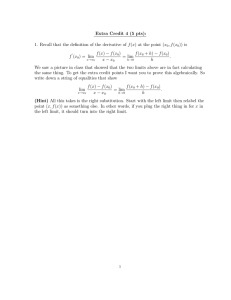

![SOLUTION OF HW3 September 24, 2012 1. [10 Points] Let {x](http://s2.studylib.net/store/data/011168953_1-36e45820ffc71e8ec27ae652a93485b4-300x300.png)
